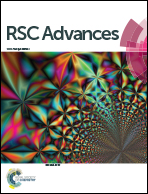A single chemosensor for bimetal Cu(ii) and Zn(ii) in aqueous medium†
Abstract
A new quinazoline derivative 6-(4-diethylamino)phenol-2-yl-(5,6-dihydrobenzimidazo[1,2-c])-quinazoline (HL) and the two metal Schiff-base complexes [CuL1Cl]·CH3OH (1) and [ZnL1(Ac)]·0.5CH3CH(OH)CH3 (2) (HL1 = 4-{[2-(1H-benzoimidazol-2-yl)-phenyl imino]-methyl}-benzene-1-diethylamino-3-ol) were synthesized and characterized by single-crystal X-ray diffraction. HL is highly selective and sensitive to Cu(II) and Zn(II) ions in aqueous medium with a detection limit of 2.13 × 10−6 and 7.19 × 10−7 M for Cu2+ and Zn2+, respectively. HL can act as a “turn-off” sensor for Cu(II) with the excitation wavelength of 356 nm and a “turn-on” sensor for Zn(II) when excited at 416 nm. The Job plots, fluorescence and UV-vis titrations, 1H NMR as well as ESI data show that the binding stoichiometry of Cu(II)/Zn(II) with HL is 1 : 1. The binding sites of HL with Cu(II)/Zn(II) are two nitrogen atoms and one oxygen atom, forming Cu(II)–L1 and Zn(II)–L1 complexes. This agrees with the crystal structures of 1 and 2.


 Please wait while we load your content...
Please wait while we load your content...